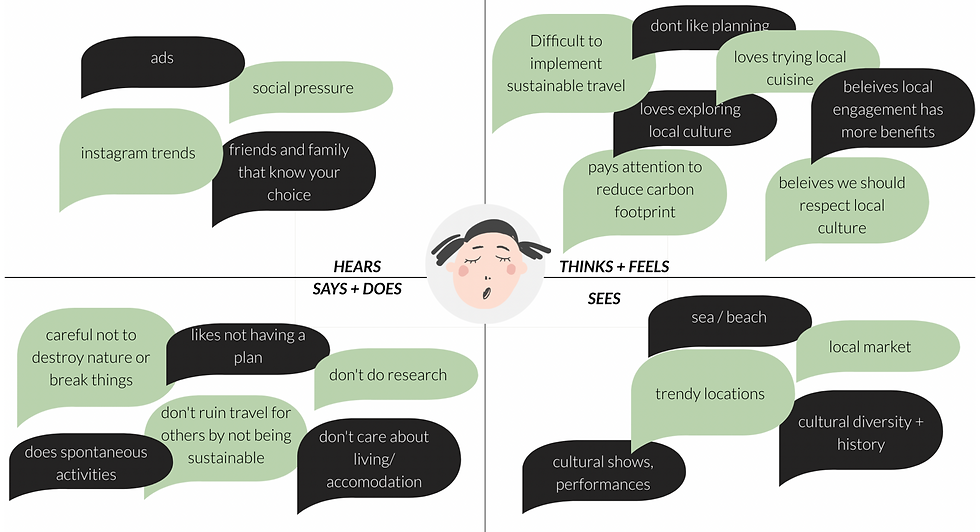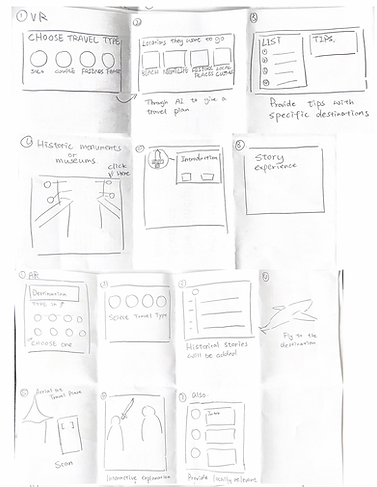top of page
EcoSense VR
A scenario based interactive game designed to educate travellers on sustainable travel habits. By showing how their actions can impact nature, it helps them make more conscious and better choices.
Duration
Six Weeks
Role
VR Prototyping, Design Research, User Interviews, Ideation, User Testing
Tools
Mozilla Spoke, Figma, Miro
Project Brief: The brief was to select one of the UN goals and use advanced technology to develop a solution for the chosen problem.
Project Overview: We choose the goal 8.9 -
PROMOTE BENEFICIAL AND SUSTAINABLE TOURISM
By 2030, devise and implement policies to promote sustainable tourism that creates jobs and promotes local culture and products.
Project Outcome: We developed a scenario based VR game to promote sustainable habits during travelling and tested the VR prototype with 8 participants.
Project Type
Group Project
Team
Krishna, Vidhi Kastiya, Xiao Yuxuan, Srishti Pai

Defining Sustainable tourism
"Tourism that takes full account of its current and future economic, social and environmental impacts, addressing the needs of visitors, the industry, the environment and host communities"
Empathise
What problem are we solving?
We created a mind map to break down the problems associated with the lack of sustainable tourism + identify various factors contributing to these problems and generate opportunities to encourage sustainable tourism.

Identified problem spaces...
Local management in tourism
Safety and crisis management
Economic benefits to local communities
Preservation of and respect for culture
Environmental protection
Management of visitor numbers
Hygine and social distancing
What AR/VR products exist in the market?
To help us layout the demand of products and services we researched the existing services in the tourism space. We were able to identify the gaps associated with the goals underlined in the UN goals.
Wintor, AR tours
7 wonders of the World
Mirage by city social

%201.png)
%201.png)
Self-guided tours:
- Museums and galleries
- Walking tours
- Parks and zoos
- Hiking trails
E-Tourism:
- Museums and galleries
- Hotel tours
- Gamified tours
- Historical Storytelling
Stay, explore, food:
- Immersive navigation
- Detect Hotels/ Restaurants/ bars
- Excursions & Travel Attractions
There is a gap for Educative solutions about travel impacts, damage to destinations, and effect on environment.
What is missing in the market?
Empathise: Primary Research
Who is the target audiance?
Method 1: Survey
This was an open survey sent out to university students, teachers and friends via emails and social media.
Q: The following aspects of sustainable tourism according to how important you think they are to sustainable tourism.

Sample: 40
Responses show that the majority audiance were:
- UK residents
- in their early 20's
- who claim to have an understanding of sustainable tourism and are willing to contribute actively to the idea.
Benefits:
- This helped better understand our audience so that we can make informed decisions.
Method 2: User Interviews


Sample: 6 people in their 20's, living in the UK
Two card sorting activities followed the interviews.
Activity 1: This OR That
Rapid choosing of travel preferences (eg. road trip OR quick flight) helped to see the difference in what people say vs what they have done in the past.
Activity 2: Rating the factors
We made participants rate factors of sustainable travel and discovered that they never consciously considered all these factors while traveling.
Benefits:
- Understand the gap between peoples' knowledge of sustainability and their actions
- Realise requirements from the participants personal experiences
Empathise: Empathy map
What do the travellers say?

User Persona
Spencer
London, Age 24
Sustainability is the last thing that comes to mind because I’m excited to just travel.
Background:
• Freelance Graphic Designer
• PGT Masters Student
• Wants to experience everything
Needs
• Wants to be rewarded for her actions
• Convenience over consciousness
• The motivation to be careful and conscious.
Pain-points
• Can’t do all things the right/sustainable way.
• Lack of awareness
• Lack of consciousness
• Conflict between convenience and ideal behaviour
• Cost comes in the way of sustainability
There is an opportunity to design a service for young travellers to guide them to travel more sustainably and create an impact that benefits the travellers and the environment.
Vision Statement
Conceptualise: Brainstorming ideas
How are we addressing user needs?
How might we? statements were generated for the selected factors - Environmental protection and Preservation of and respect for culture/nature, Local engagement in tourism and Economic benefit to local communities..
This helped us to:
- narrow down the opportunities and trace the relevant ones back to the goal and the vision.
- check that all members of the team were clear about the scope of the design opportunities.

Visualising the ideas
A few HMW statements selected by voting were presented to other designers in the class and ideas were brainstormed using the crazy 8 exercise.
This helped us branch out to innovative ideas and then narrow down the one's that aligned with the our vision.


What are the best ways to address these problems?

Speed up exploration and recovery
AI
Maintain a real experience
VR
Giving customised advice
MR
Enrich the user interaction
AR
Design: Experience prototyping
Presenting the idea to the users.
Before building the VR environment we used experience prototyping to establish clarity early on in the development lifecycle.
This helped:
- With rapid resolution of misunderstandings within the project team.
- Understand the user perspective.
- User feedback allowed us to narrow down our story narrative.


What did we understand from the users?
Findings:
- Users want to be more in control
- Users want to know the progress of the activity.
- Users agree that interaction will allow more information retention.
- Users want more information on environment-related crises.
- Users are doubtful of providing information during the experience.
Iterations made:
- Drive users through a particular scenario.
- VR Booth rather than relying on a user headset.
- Travel advice particular to a gate at the airport.
Conceptualise: User Testing
How did we test the prototype?
Users interacted with the VR prototype using headsets and completed the tasks of exploring the beach setting in the virtual environment.
Method: Qualitative observation and think aloud to assess emotional reaction to the prototype.
The goal was to uncover Knowledge retention and Engagement.
The following points were used for post interaction assessment Knowledge retention:
1. What elements do you remember from the scene
2. What subject matter is the VR scene about
3. What would you do next in this environment
4. Did the environment feel comfortable?
What did we find from user testing?

%201%201.png)
EcoSense VR is a scenario based interactive game that uses user interactions to generate a storyline to educate users of the impact of their actions during travel on nature and hence help them consciously make better choices.
What is EcoSense VR?
Enter how you travel
solo/friends/family
AI recommends activities based on your choice
Choose a scenario of your choice
Enter scenario
What are the core features of EcoSense VR ?
1. Virtual Reality
2. Behaviour Change
Interactive activities in the VR environment of the users choice makes the solution engaging. Immersive setup will lead to more interest from the audience.
Make your own story by interacting with the elements in the virtual world.
The consequences of the users actions will be displayed to them using educative videos increasing empathy and awareness related to their travel habits.
This prepares them in advance to their travel on things they should and should not do to practice sustainability while traveling.
3. Artificial Intelligence
AI makes the experience personalised to each traveller and their choice of place, setting, activity, behaviour and so on.
This helps the user gather actionable recommendations based on their individual travel situation.
Design:
How does the Virtual world work?
Interactive elements
Navigation
Medium fidelity prototype
- Recognisable links
- Action instructions alongside objects
Arrows


Recommendations for High fidelity prototype
- Glowing objects to call for action
- Bounce to grab attention
- Audio cues to navigate directions
- Immersive sounds of scenario to lead to different activities
Vision in the Virtual Environment.

Visualise: Risk Analysis
What are the limitations of EcoSense VR?
01
Time to get used to the headset and virtual environment.
02
Heavy VR device. People not experienced with VR gear or with other health problems will find this inconvenient.
03
User privacy and data security. People will use this for short durations and to add a reward afterwards the data collected from users needs to be monitored carefully.
What is the scope of future development?
01
Increased awareness through several environmental areas.
History of visited locations to encourage use
02
An augmented reality (AR) experience for route navigation and informational purposes when travelling.
03
A local market online purchasing experience that is immersive for locations that are far away.
bottom of page